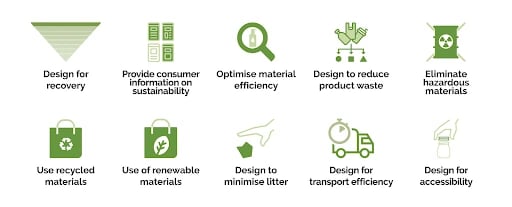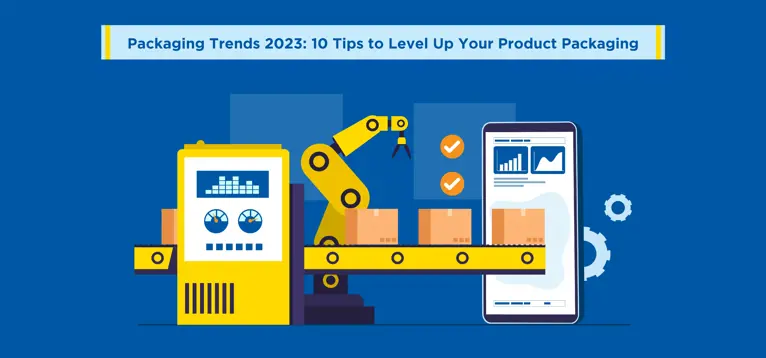If you think the only purpose of product packaging is to pack your product, think again.
Product packaging design influences the purchase decisions of a good 72% of consumers.
And 30% of businesses also claim that they observed a significant revenue after improving their packaging.
Product packaging designs may not be the first thing to look into in marketing. Yet, it’s a driving force that influences your sales volume and revenue.
Customer expectations are changing and packaging has become a medium for telling a brand story. At the same time, your packaging is also something that needs to be durable and convenient for your freight service provider to handle when your goods are in transit.
To meet the latest packaging requirements, you need to be aware of the latest product packaging trends and protocols that brands are following while packaging their products.
With that, let’s dive into the top 10 tips to upskill your product packaging in 2023.
Tip 1. Choose the Right Packaging Material
Quality plays a central role in the sale of a product. High-quality packaging means choosing the right packaging material and avoiding substandard materials since they can damage your product during transportation.
Some of the most common packaging materials that companies use are paper, plastic, cardboard, aluminium, etc. While they’re easily available according to different shapes and sizes, you need to check their functionality and whether they would work best based on your product type.
Opt for packaging solutions that smoothly transport your product using state-of-the-art packaging techniques. Customers enjoy a good unboxing experience which starts with packaging.
Also, packaging that feels cheap will be discarded. If you use high-quality materials, customers will be encouraged to preserve your packaging and reuse them.
Tip 2. Get your Colours Right
We can not talk about product packaging without mentioning colours. You probably hear it again and again, get your product colours right. And it will always be an ongoing product packaging trend.
Because colours hold immense psychological value in packaging and play an important role in your ability to connect with your customers. Brands that have focused on colour-based packaging have managed to build a unique positioning amongst their customers.
To know what colours resonate with your customers, first, get the customer demographics right. Getting to know your customers and understanding their requirements allows you to choose colours that stimulate the right emotions in your customers.
While adhering to the emotions of the customers, it’s also important to choose a colour combination that best reflects your brand. Your colour choices contribute to the packaging’s clarity.
So get creative, try out different combinations of colours and choose the one that strikes a balance between your brand positioning and product relatability.
Tip 3. Be Honest
Honesty is a product packaging trend that is never going out of style. A well-packed product is a combination of attractiveness and informativeness. Whatever you mention on your packaging, be it words or symbols needs to represent your product accurately.
Your customer notices these things. They won’t be happy to experience a product that differs from the one shown on the packaging.
It can mean as simple as what material is their piece of clothing, or how much percentage of sugar a packet of biscuits contains. Like many packaging designs out there, you can also use images, logos, or symbols to send an honest message.
Honesty isn’t just important for the customer's trust. It can land you in legal trouble if you include any dishonest information on the packaging.
Tip 4. Learn from the Competition
Since your competitors are selling the same product, it’s always a good idea to take inspiration. Knowing how similar brands are leveraging packaging not only helps you know what can work best for your products but also helps you identify what makes you stand out.
Good packaging can turn out to be a competitive advantage. Even if everything's the same, the customer may choose the competitor’s product over yours simply because of the packaging.
For example, imagine you’re still using cheap plastic to save costs and the competitors have decided to upskill their packaging with metal cans.
It may not happen immediately but gradually, customers will start preferring cans since they’re more durable. Instead, it’s good to be a step ahead and pay attention to the latest trends in packaging and adopt them at the fastest rate.
Tip 5. Consider Practical Designs
Your packaging has to be convenient — whether you’re packing products for logistics or selling them to the end consumer. Follow the packaging guidelines and standards to ensure your products are delivered safely to their destination.
Have different packaging for different sizes and types of products. A practical design needs to ensure that your packaging is:
- Abe to protect the goods
- Transportable and compliant
- Accessible
- Showcasing the content
- Sustainable
- Reusable
For example, even though shampoo and toothpaste are thick fluids, they’ll require different packaging because of their viscosity. Their use and storage practices are also different. It is ultimately the product content that decides what type of packaging is the most practical.
Tip 6. Test Shipment-friendly Packaging
Your product needs to withstand the delivery process. Some products have a longer shipping duration than others. If they’re transported through sea freight or air freight, they also need to be properly packed to endure the long distances and different weather conditions.
Product packaging should protect the contents inside from spilling, breaking, separating, or falling out during transit or getting damaged in any way.
This means you pack the insides with soft inserts like packing peanuts and bubble wrap if it's an electronic product. Similarly, you use ties to hold electrical cords or sealed lids on liquids.
Most shipping service providers are aware of the packaging regulations for particular products. Ensure that the freight and courier service provider you choose understands how to professionally pack, load and unload the products at docks, and safely deliver them at the destination.

Tip 7. Practice Sustainability
Sustainability has been a product packaging trend for a while now. In the name of being fancy or standing out, brands end up using a lot more material for packaging than a product actually requires.
Companies need to know that sustainable packaging helps them be environmentally responsible and it earns them a positive reputation from the customers.
Studies show that 54% of consumers ages 44 and under consider sustainable packaging. Customers are also willing to pay more for a sustainably packed product.
It means that even if you incur a higher cost of going green, you should. The budget shouldn’t be a constraint since customers will feel happier buying your product as they know they’re being environmentally responsible.
Sustainable Packaging Guidelines

Tip 8. Don’t forget to include Instructions
For product packaging to tell your brand story, it’s important that you include the right instructions on the material. Understand what information and instructions are necessary for the products and how your audience would like to receive these details.
Some products are usually self-explanatory. In that case, you can take the opportunity to keep the information light-hearted and not patronise the customer.
If further information is required, make sure you consider the problems that the product is solving when providing instructions. Instructions are also necessary when you ship your items. Special care goods need to be clearly labelled as how they should be handled in transit.
Tip 9. Opt for Professional Printing Services
If we’re talking about packaging quality, you cannot afford to ignore the printing quality itself. You can easily distinguish between a professionally printed package versus an amateur-printed package.
Before you look around for a professional printing service, check what kind of services you need and the price range you can afford. Consider the printing volume required, the competition time, the pricing options, and the methods used for printing.
Check if your chosen printing service provider matches your quality standards and aligns with your branding. A lot of times, customers judge the product on its printing quality. High-quality printing gives customers a glimpse of how well-made the product is.
Tip 10. Consistent Brand Details
While we’ve talked about how you need to ensure your brand stands out in the product packaging by using the right colour combinations and logo, you need to remember to be consistent about the details.
Brands usually have an appeal and a standing that customers relate the brand with. You need to ensure that your product packaging aligns with your overall brand image.
For example, for a brand that has marketed itself as a sustainable footwear brand, your packaging materials need to be eco-friendly that ultimately reflect your brand values. Use your packaging to tell the larger story and showcase your mission.
Finishing Thoughts
The above trends reflect that product packaging is more than just packaging. And with so many factors and tips to keep in mind, it is ideal to choose a packaging partner that takes care of the technical aspects of product packaging.
PACK & SEND can take responsibility for your dispatch and package your items sensitively. You can get in touch with us to understand how we can aid with your product packaging requirements.
Image Sources: Advancedinstaller, Apco.org
